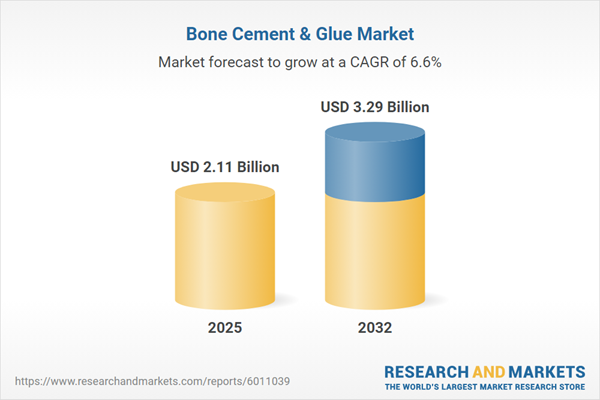Speak directly to the analyst to clarify any post sales queries you may have.
The Bone Cement & Glue Market is evolving rapidly, driven by technological progress, shifting demographics, and emerging clinical demands. Senior executives and stakeholders in medical device, orthopedic, and health services sectors will find this report a strategic resource for navigating complex trends and capturing growth opportunities.
Market Snapshot: Bone Cement & Glue Market Size and Growth
The global Bone Cement & Glue Market grew from USD 1.98 billion in 2024 to USD 2.11 billion in 2025. With a projected CAGR of 6.56%, the market is expected to reach USD 3.29 billion by 2032. Factors contributing to robust expansion include the growing incidence of osteoporosis, the adoption of minimally invasive surgical techniques, and ongoing regulatory changes across major healthcare regions.
Scope & Segmentation: Comprehensive Market Coverage
- Product Types: Acrylic bone cement (antibiotic loaded, non-antibiotic loaded), calcium phosphate cement (injectable, moldable)
- Applications: Craniomaxillofacial (reconstructive surgery, trauma repair), dental (implantology, restorative), orthopedic (fracture fixation, joint replacement, spinal surgery)
- End Users: Ambulatory surgical centers (multi-specialty, orthopedic centers), hospitals (private, public), specialty clinics (dental clinics, outpatient rehab)
- Technologies: Bioactive (calcium phosphate, calcium silicate), PMMA-based (high viscosity, low viscosity)
- Distribution Channels: Direct sales (OEM relationships, tender contracts), distributors (group purchasing organizations, independent distributors), online channels (e-commerce platforms, manufacturer website)
- Regions: Americas (North America: United States, Canada, Mexico; Latin America: Brazil, Argentina, Chile, Colombia, Peru), Europe, Middle East & Africa (Europe: United Kingdom, Germany, France, Russia, Italy, Spain, Netherlands, Sweden, Poland, Switzerland; Middle East: United Arab Emirates, Saudi Arabia, Qatar, Turkey, Israel; Africa: South Africa, Nigeria, Egypt, Kenya), Asia-Pacific (China, India, Japan, Australia, South Korea, Indonesia, Thailand, Malaysia, Singapore, Taiwan)
- Companies Analysed: Zimmer Biomet Holdings Inc., Stryker Corporation, DePuy Synthes Inc., Heraeus Medical GmbH, Smith & Nephew plc, B. Braun Melsungen AG, Medtronic plc, TEI Biosciences Inc., DJO Global Inc., Paragon 28 LLC
Key Takeaways: Strategic Insights for Decision-Makers
- Material innovation is expanding clinical application options, with advanced composites and bioactive formulations enabling improved patient outcomes in osteointegration and tissue regeneration.
- Regulatory requirements have tightened globally, compelling manufacturers to strengthen evidence generation, postmarket surveillance, and compliance across multiple jurisdictions.
- Demand is increasingly shaped by demographic trends such as population aging and the rising incidence of degenerative joint diseases, underlining the relevance of minimally invasive and moldable adhesive alternatives.
- Distinct needs among end users are driving portfolio diversification: ambulatory centers focus on quick-acting solutions, hospitals require large-scale support, while specialty clinics seek compact packaging and single-use formats.
- Supply chain partners are adapting to regional and sector-specific purchasing models, including tiered pricing and broader distribution footprints, to reduce market risk and improve service continuity.
Tariff Impact: Navigating Regulatory and Trade Challenges
Recent tariff adjustments in the United States have increased costs related to raw materials for bone cement and glues. Manufacturers are countering these disruptions by shifting sourcing strategies, expanding nearshoring, and reallocating R&D toward alternative, tariff-exempt formulations. These responses influence pricing strategies and require review of procurement frameworks across major customer segments, especially hospitals and group purchasing organizations.
Robust Methodology & Data Sources
The report’s findings are underpinned by a thorough multi-tiered methodology. Primary research involved expert interviews with clinicians, procurement executives, and material scientists. Sources include peer-reviewed journals, regulatory databases, device registries, and proprietary company data. Triangulation of inputs and advanced statistical analysis underpin all segment, region, and technology assessments.
Why This Report Matters: Actionable Decision Support
- Enables informed market entry and expansion by mapping segmentation, technology adoption, and regional drivers.
- Supports strategic scenario planning for supply chain resilience and R&D investment in light of evolving regulations and tariffs.
- Facilitates alignment with clinical practice shifts and procurement trends, positioning organizations for sustained growth and innovation.
Conclusion
This executive analysis outlines a dynamic market landscape shaped by technology, regulation, and demographic shifts. Companies that adapt portfolios, strengthen compliance, and invest in resilient supply chains will be well-positioned to succeed.
Additional Product Information:
- Purchase of this report includes 1 year online access with quarterly updates.
- This report can be updated on request. Please contact our Customer Experience team using the Ask a Question widget on our website.
Table of Contents
3. Executive Summary
4. Market Overview
7. Cumulative Impact of Artificial Intelligence 2025
Companies Mentioned
The companies profiled in this Bone Cement & Glue market report include:- Zimmer Biomet Holdings, Inc.
- Stryker Corporation
- DePuy Synthes, Inc.
- Heraeus Medical GmbH
- Smith & Nephew plc
- B. Braun Melsungen AG
- Medtronic plc
- TEI Biosciences, Inc.
- DJO Global, Inc.
- Paragon 28, LLC
Table Information
| Report Attribute | Details |
|---|---|
| No. of Pages | 186 |
| Published | October 2025 |
| Forecast Period | 2025 - 2032 |
| Estimated Market Value ( USD | $ 2.11 Billion |
| Forecasted Market Value ( USD | $ 3.29 Billion |
| Compound Annual Growth Rate | 6.5% |
| Regions Covered | Global |
| No. of Companies Mentioned | 11 |









